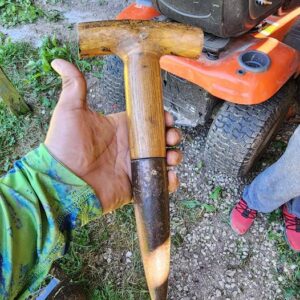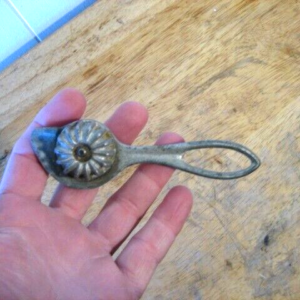A questioner said:
Found in a basement of a old house. What was it used for?

Some of the answers:
- It’s a model steam engine, like the sort Keith Appleton makes on YouTube. You have a boiler to blow steam into the tube (or just compressed air) and it turns the wheel. They’re just for fun.The metal is mostly bought as cast iron kits that need to be machined carefully to make all the parts fit. If they aren’t skilfully made the steam engine will have a poor rhythm or won’t even run, so it’s a test of engineering skill to make one that runs well.
- Might not be a toy engine so much as small. Something this size might be used to power a washing machine or other small machine. Do you have pictures of markings, hallmarks, plates, or labels? Those could be used to identify it’s purpose.
- It is a horizontal steam engine made as a final project in a vocational machining class. It is not a toy, mass produced, a model, or a demonstration piece (too sloppy). It would be strong enough to be functional, but didn’t need to be, so there is no flatbelt pulley or drive gear or cog on the other side of the flywheel, nor is the flywheel a v-belt pulley (which would be a bad design anyway). These were made as projects long after steam fell out of fashion; I would guess the student made it sometime before 1970.
- Kinda looks like an old Stirling Engine.
- Best to look around for the water container and little flame burner! Then you can give it a spin. By the way I used to have one with my dad. I am not sure if it still there after 40+ years, gotta ask.
- It’s definitely a belt driving reciprocating pump, but can’t tell what kind. See any oil? Could’ve been for water or fuel oil.
- There used to be a little get together in a park, in Zolpho Springs FL every year where people would have all sorts of old engines, including model steam engines and old one stroke gasoline engines. It was called Pioneer Park Days and it was pretty neat to walk around and see all the old engines, many of which worked. There would be a lot of old tractors there as well.
- looks like something steampowered.
- What a lucky kid who got to play with that in yesteryear
- I hope you drop a little fresh oil in it and use some compressed air to make it run! They are fascinating to watch. Please post a video if you do!
- My grandpa had one of these when I was a kid, i think it’s in his attic now.
- Always wanted a real steam engine model as a kid.. I had to stick with lego and melted plenty of axles while stripping gears. 40psi is pretty fun
- Model steam engine, no boiler though
- Isn’t that the machine that makes you fall asleep for 100 years or something like that?
- Looks like a little steam engine or some kind of pump.
- Ok steam pros. Could a small steam engine replace the gasoline engine in a modern hybrid automobile? Boiler uses a quick heat electric element?
What do you think it is used for?
In the dimly lit confines of an ancient basement, tucked away beneath layers of dust and forgotten memories, lies an enigmatic artifact—an object shrouded in mystery, whispering tales of its past. Discovered amidst the timeworn walls of an old house, its purpose remains a puzzle waiting to be solved.
The journey begins with the curious explorers who stumbled upon this hidden gem. As they descended into the depths of the basement, their eyes were met with an array of relics, each bearing the scars of time. Amidst the clutter, one object stood out—an intricately crafted apparatus, its design both unfamiliar and intriguing.
Upon closer inspection, the artifact revealed itself to be a mechanical contraption, adorned with gears, levers, and peculiar symbols etched into its surface. Its purpose, however, remained elusive, prompting the question: What function did this mysterious device serve?
To unravel the mystery, we delve into the history of the old house and its former inhabitants. Records indicate that the house dates back to the late 19th century, a time of innovation and industrial progress. Could this artifact be a product of that era—a testament to the ingenuity of its creators?
Speculation runs rampant as theories emerge regarding the artifact’s possible uses. Some believe it to be a relic of early scientific experimentation—a device designed to harness the power of electricity or delve into the realms of alchemy. Others suggest a more practical purpose, citing its resemblance to machinery used in textile mills or clockmaking workshops.
Yet, amidst the conjecture, one prevailing theory begins to take shape—a hypothesis rooted in the everyday lives of those who once inhabited the house. Could it be that this mysterious artifact served a domestic function—a tool designed to simplify household chores or enhance daily routines?
As researchers delve deeper into the artifact’s design, parallels emerge with devices used for food preservation, laundry wringing, or even butter churning—mundane yet essential tasks of yesteryears. Perhaps this mechanical marvel was once a humble companion in the daily lives of its owners, silently aiding them in their domestic pursuits.
Nevertheless, the true purpose of the artifact remains shrouded in ambiguity, its secrets locked away within the confines of time. As historians, archaeologists, and enthusiasts alike continue to unravel its mysteries, one thing remains certain—the discovery of this enigmatic artifact serves as a reminder of the rich tapestry of history woven into the fabric of everyday objects.
So, as we gaze upon the artifact found in the basement of an old house, we are reminded of the countless stories it holds—the lives it touched, the secrets it guards, and the endless possibilities that lie within its intricate design. In a world where the past and present intertwine, perhaps some mysteries are meant to endure, leaving us captivated by their allure for generations to come.



